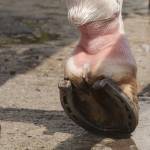To Shoe or Not To Shoe?

The decision on whether or not to shoe a horse is usually based on one or more of the following criteria:
- Protection. Shoes protect the hoof from being worn down or chipped by wearing against hard ground, rocks, or pavement. By raising the sole further off the ground, they protect the bottom of the hoof from bruising caused by rocks or frozen ground. If the hoof has been injured or punctured, shoes can hold pads that keep dirt from contacting open or damaged areas.
- Traction. Shoes with toe grabs, calks, or studs help horses dig into the ground so they can move more easily without slipping. For work on pavement, ice, or other slippery surfaces, shoes can have borium brazed onto the shoe to provide excellent traction and prevent sliding.
- Gait alteration or enhancement. The weight and balance of a shoe changes the way a horse moves its leg and foot. This can be corrective, as in shoes that prevent racehorses from hitting one leg with another hoof as they run. Shoeing can also exaggerate movement and is used to lengthen and enhance the stride of gaited horses.
For assistance in deciding whether or not your horse needs shoes, contact a trainer, farrier, and/or veterinarian. Based on the horse’s age, training, use, conformation, and specific problems, these professionals can determine the best choices if shoes are indicated. Whether or not your horse wears shoes, his hooves should be trimmed about every four to six weeks.








